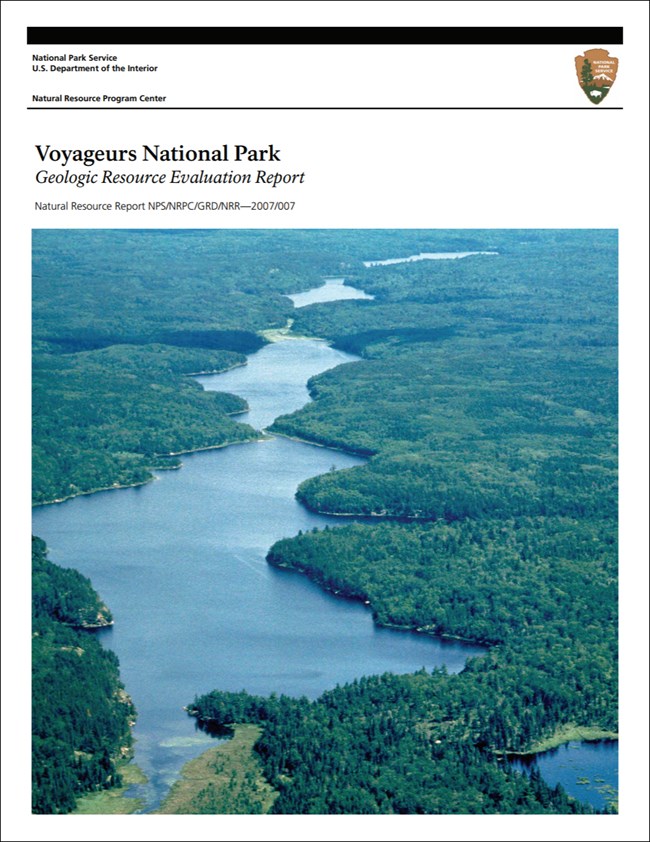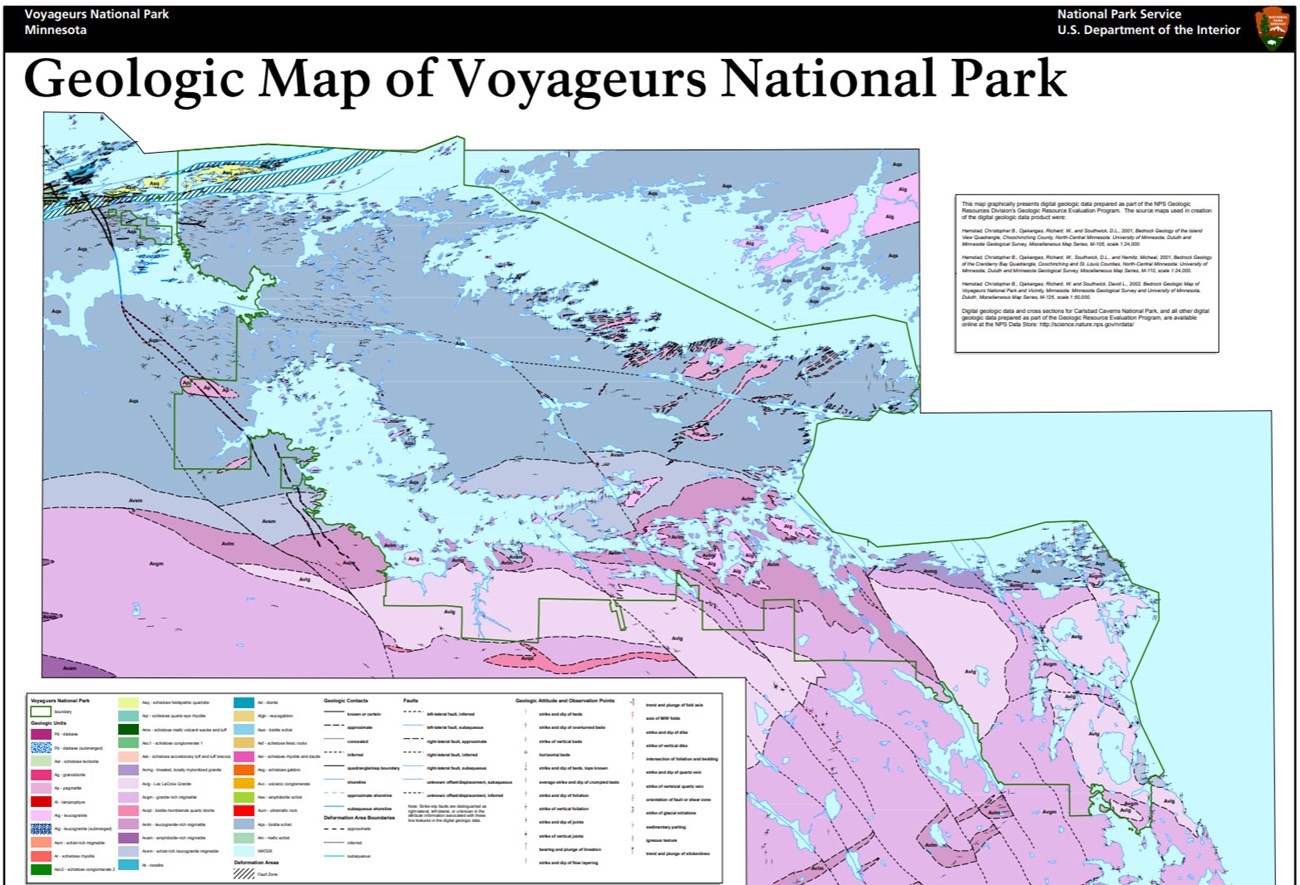Last updated: July 17, 2024
Article
NPS Geodiversity Atlas—Voyageurs National Park, Minnesota
Geodiversity refers to the full variety of natural geologic (rocks, minerals, sediments, fossils, landforms, and physical processes) and soil resources and processes that occur in the park. A product of the Geologic Resources Inventory, the NPS Geodiversity Atlas delivers information in support of education, Geoconservation, and integrated management of living (biotic) and non-living (abiotic) components of the ecosystem.

Geologic Features and Processes
Located in the southern part of the Canadian Shield and sharing a common boundary with Canada, Voyageurs National Park contains some of the oldest rocks on the North American continent and forming the ancient core of the continent (Hemstad et al. 2002).
Geologic features and processes in Voyageurs reflect the two widely separated time periods that formed the present landscape: the older, 2.5 billion year old Precambrian (Archean) and the Pleistocene Epoch ice age.
The Archean rocks at Voyageurs are associated with a mountain- building episode called the Kenoran (Algoman) orogeny. The Kenoran orogeny is the earliest datable orogeny in North America (Harris et al. 1995). Both igneous and metamorphic rocks are exposed in Voyageurs. Schists and gneisses, the products of metamorphism, are exposed in the west and central portions of the park (Rainy Lake and Kabetogama Lake) while granite, an igneous rock, is exposed on the east end at Namakan Lake and Sand Point Lake.
During the Ice Age in the Pleistocene Epoch, which began about 190,000 years ago, the region experienced at least four periods of glaciation that shaped and carved the bedrock into the landscape seen by visitors today (Davis et al. 1994; Weeks and Andrascik 1998; Kiver and Harris 1999).
Glacial Landforms and Features
The advance and retreat of Pleistocene glaciers as recently as 10,000 years ago left an indelible imprint on the rock in Voyageurs. Characteristic features of continental glaciation observed in Voyageurs range from scratches and grooves on bedrock to the chain- like pattern of lakes that formed from glacial scouring.
Glacial erratics, or ice- rafted rocks, are abundant in the park. These displaced blocks range in size from pebbles to blocks the size of automobiles. Ground moraine debris, interspersed with lakebed sediments, forms a distinctive undulating topography.
Glacial striations striations and glacial grooves appear as parallel, linear scratches or furrows on bedrock and erratics. Striations form from the scraping and scratching of quartz grains and hard, sharp rock fragments frozen into the bottom of the ice scratching across rock surfaces as glaciers move. Striations are generally oriented in the direction of glacial movement. In Voyageurs National Park, striations point south, south by southwest, and southwest (Harris et al. 1995). Cross- striations on some outcrops indicate more than one direction of ice movement.
Repeated abrasion by glacial movement has smoothed and polished many of the bedrock exposures in the park. On highly resistant outcrops in Voyageurs, glacial polish still appears glossy and fresh or only slightly weathered.
Glacial landforms can be observed throughout the region's dozens of lake basins, outwash (mostly sand and gravel), and till deposits. Today the rugged and varied topography includes rolling hills interspersed with irregular slopes and outcrops of bedrock between bogs, beaver ponds, swamps, islands, small lakes, and the four large lakes.
Regional Geology
Voyageurs National Park is in the Superior Upland Physiographic Province. The Superior Upland Physiographic Province in the Voyageurs area is divided into two subprovinces: the Quetico subprovince and the Wabigoon subprovince separated by the Rainy Lake- Seine River fault zone. The park is mostly in the Quetico subprovince which is composed primarily of biotite schists and granitic rocks with only rare evidence of regional volcanic activity. The Wabigoon subprovince, however, is extremely variable. It contains numerous intrusive bodies and volcanically- derived greenstone belts. The Wawa subprovince also contains greenstone belts, but they are more localized and do not extend into Voyageurs. These rocks represent the juxtaposition of a sedimentary basin (Quetico subprovince) with a volcanic island arc (Wabigoon subprovince) (Davis et al. 1994).
Maps and Reports
- Scoping summaries are records of scoping meetings where NPS staff and local geologists determined the park’s geologic mapping plan and what content should be included in the report.
- Digital geologic maps include files for viewing in GIS software, a guide to using the data, and a document with ancillary map information. Newer products also include data viewable in Google Earth and online map services.
- Reports use the maps to discuss the park’s setting and significance, notable geologic features and processes, geologic resource management issues, and geologic history.
- Posters are a static view of the GIS data in PDF format. Newer posters include aerial imagery or shaded relief and other park information. They are also included with the reports.
- Projects list basic information about the program and all products available for a park.
Source: NPS DataStore Saved Search 3191. To search for additional information, visit the NPS DataStore.
A NPS Soil Resources Inventory project has been completed for Voyageurs National Park and can be found on the NPS Data Store.
Source: NPS DataStore Saved Search 3216. To search for additional information, visit the NPS DataStore.
Related Articles
Voyageurs National Park
National Park Service Geodiversity Atlas
The servicewide Geodiversity Atlas provides information on geoheritage and geodiversity resources and values within the National Park System. This information supports science-based geoconservation and interpretation in the NPS, as well as STEM education in schools, museums, and field camps. The NPS Geologic Resources Division and many parks work with National and International geoconservation communities to ensure that NPS abiotic resources are managed using the highest standards and best practices available.


